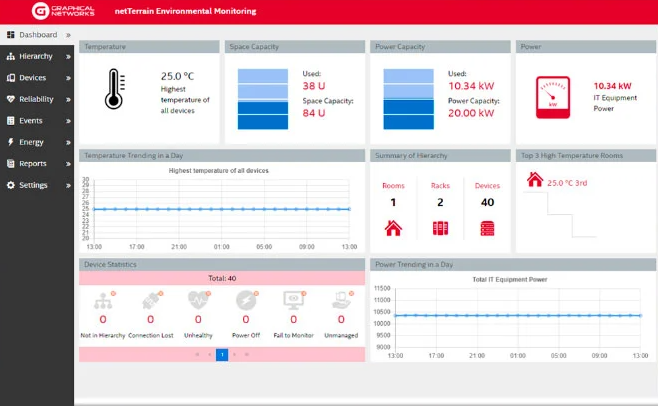
When we worked at netViz back in the early 2000’s, I remember several companies getting started in IT documentation, mainly Aperture and Rackwise, that then started to focus on DCIM. Anyone still remember them? Our team does: afterall, the other founding members and I at Graphical Networks all came from netViz, and we’ve been selling data center and network documentation long before the term ‘DCIM’ was even coined.
DCIM: The Beginning
As this article isn’t going to give you a complete history but the essentials, I’ll make it brief. Back when data center infrastructure management software (DCIM) first hit the market, no one knew quite what to make of it. As data centers started to grow at exponential rates due to the rise of data, it quickly became apparent that an enterprise-grade platform for improving how data centers were run was needed, that was certain, but what, exactly, was DCIM and what results would it deliver?
- In 2010: marketers promised that DCIM would improve performance.
- In 2011: the promise of DCIM had evolved: it would help data center managers fix inefficiencies.
- In 2012: the promise was that DCIM would allow managers to monitor all parts of a data center’s infrastructure.
- In 2013: the idea was DCIM would help actually manage the data center without even needing to step foot in it.
- In 2014: the promise had both simplified and expanded at the same time: DCIM would help organizations save millions of dollars.
- In 2016: the US federal government dictated that all federal data centers had to use DCIM to lower data centers’ power usage effectiveness (PUE) ratios by 2018.
As you can see: for a few years there, DCIM had developed a strong reputation…then…something happened around 2017.
DCIM: The Middle Years
An IT consultant famously made the claim that DCIM was a camel as it wasn’t delivering on its promises. Why, he said, should anyone bother to ‘revive’ it? Shortly after that, several DCIM software companies started to sunset their solutions or merge with other key power software/hardware companies such as: iTracs, Rackwise, Fieldview, DC Track (all acquired by Vertiv, who also discontinued their Trellis DCIM), CA (and even nLyte — which was recently acquired).
What happened?
The initial promises of DCIM changed as data centers evolved and DCIM proved hard to get up and running, for example: building the catalog/templates was so time consuming. As a result, there was a backlash against DCIM by scorned users who felt they were left with some flashy and expensive shelfware.
DCIM: The Present
So, where does that leave DCIM today?
DCIM’s here to stay. Instead of every vendor under the sun offering some kind of DCIM solution, it’s been consolidated to few niche DCIM vendors, such as: DCIM, Sunbird, and Device 42. Nowadays, DCIM isn’t promising to boil the ocean. It’s not replacing the need to step foot in a data center entirely. It does, however, save time and money, and it is still a crucial element that can unify the various moving parts in a modern data center.
DCIM in 2022 — and beyond — helps data center managers know if they have the availability they need. It helps data center managers reduce power expenses and ensure that energy usage is optimized. It helps with change management — such as tracking various migration projects, changes and additions to equipment and ports. It assists Data Center Managers with tracking and managing hybrid and cloud infrastructures, It also helps data center managers plan for capacity to ensure availability while keeping the infrastructure right-sized. Finally, it helps data center teams manage their assets, cabling, and the applications that depend on the assets.
 Example: Power Monitoring in netTerrain DCIM
Example: Power Monitoring in netTerrain DCIM
One-click integrations to other data sources (for example: in netTerrain DCIM), such as ServiceNow, Solarwinds, using REST APIs and built-in network discovery helps getting your DCIM data populated in a much more rapid deployment, than in the past when it meant having to spend months upon months of costly professional services, which was the initial downfall for many of these large DCIM implementations.
In sum: if you are looking for DCIM, ask your DCIM vendor how to connect to other data sources, does it require lots of services days or months to implement. Ask how the DCIM vendor catalog/library of devices are built, maintained, and if they provide their own images of the devices in their catalog, or if it is something you will need to do on your own (talk about time consuming!).
Please make sure you have the right team members that need to be involved in defining the requirements for your DCIM solution from the onset. For example, the number of times I have seen companies use DCIM for power monitoring but not managing their cabling infrastructure. You don’t want to go out and buy two products (DCIM and a Cable Management System), where one DCIM solution can do both!
If you’d like to test-drive netTerrain DCIM, we’re here to help. We can set you up with a 100% free trial, or a demo, or both. Click here to get started.